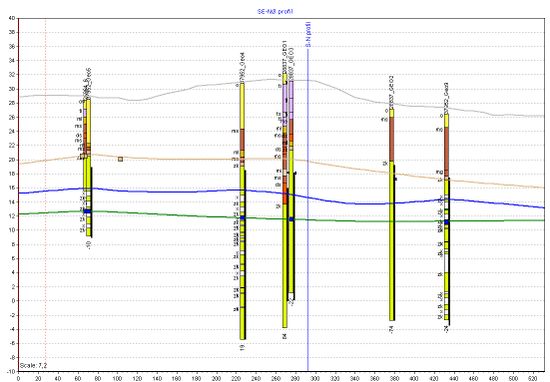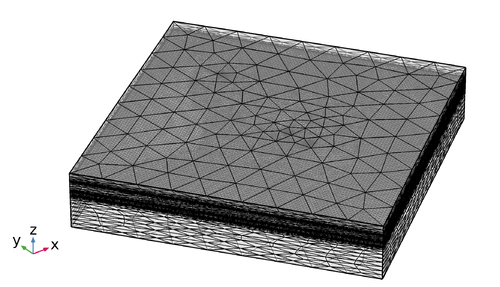Difference between revisions of "Model setup"
m (→Model setup for fracture flow and transport in limestone aquifers - steps) |
m (→Model setup for fracture flow and transport in limestone aquifers - steps) |
||
| Line 30: | Line 30: | ||
* Improve risk assessment, e.g. for a drinking water well, in order to assess future actions | * Improve risk assessment, e.g. for a drinking water well, in order to assess future actions | ||
* Delineate the capture zone of a well | * Delineate the capture zone of a well | ||
| + | * Test hypothesis | ||
</div> | </div> | ||
</div> | </div> | ||
| Line 75: | Line 76: | ||
<div class="collapsiblebar mw-collapsible mw-collapsed"> | <div class="collapsiblebar mw-collapsible mw-collapsed"> | ||
| − | |||
=== Data acquisition - measurements to obtain relevant model parameters (see list of parameters for each model) === | === Data acquisition - measurements to obtain relevant model parameters (see list of parameters for each model) === | ||
<div class="mw-collapsible-content"> | <div class="mw-collapsible-content"> | ||
| Line 85: | Line 85: | ||
=== Implementation of parameters for selected units in the model domain (homogeneous/heterogeneous) === | === Implementation of parameters for selected units in the model domain (homogeneous/heterogeneous) === | ||
<div class="mw-collapsible-content"> | <div class="mw-collapsible-content"> | ||
| − | Based on available data, parameter distributions | + | Based on available data and the chosen model, parameter distributions have to be defined. |
| − | For a flow simulation, the hydraulic conductivity (or permeability) and | + | For a steady-state flow simulation, the hydraulic conductivity (or permeability) is required. |
| + | For transport, parameters like porosity, (effective) diffusion coefficients, dispersivities and sorption parameters are required. | ||
</div> | </div> | ||
</div> | </div> | ||
| Line 93: | Line 94: | ||
=== Choice of boundary conditions and sources/sinks === | === Choice of boundary conditions and sources/sinks === | ||
<div class="mw-collapsible-content"> | <div class="mw-collapsible-content"> | ||
| − | Boundary conditions have to be chosen according to known values, like a constant head or a known | + | Boundary conditions have to be chosen according to known values, like a constant head or a known in-/outflow. |
The most common boundary conditions are | The most common boundary conditions are | ||
| − | * Dirichlet conditions (or first-type boundary conditions), where the primary variable is fixed to a value (e.g. fixed head or fixed concentration) | + | * Dirichlet conditions (or first-type boundary conditions), where the primary variable is fixed to a value (e.g. fixed head or fixed concentration). |
| − | * Neumann conditions (or second-type boundary conditions), where the gradient of the primary variable is specified (e.g. flux across the boundary, no-flow) | + | * Neumann conditions (or second-type boundary conditions), where the gradient of the primary variable is specified (e.g. flux across the boundary, often no-flow boundaries) |
* Cauchy conditions (or third-type boundary conditions), which sets a condition to the primary variable and it's derivative (used f.e. for the flux through a river bed). | * Cauchy conditions (or third-type boundary conditions), which sets a condition to the primary variable and it's derivative (used f.e. for the flux through a river bed). | ||
The boundary conditions should be chosen according to known boundaries, such as geologic boundaries, known head isolines, known flowlines (these can be used as no-flow condition perpendicular to them). | The boundary conditions should be chosen according to known boundaries, such as geologic boundaries, known head isolines, known flowlines (these can be used as no-flow condition perpendicular to them). | ||
| + | The choice of the boundary condition is a very important step and determines the calculated results. | ||
| + | |||
Sources and sinks are employed to include e.g. withdrawal/injection at wells or groundwater recharge due to precipitation. | Sources and sinks are employed to include e.g. withdrawal/injection at wells or groundwater recharge due to precipitation. | ||
</div> | </div> | ||
| Line 114: | Line 117: | ||
<div class="mw-collapsible-content"> | <div class="mw-collapsible-content"> | ||
[[File:MeshExample.png |thumb|right|500px|Example a mesh used for discrete-fracture simulations of the Akacievej tracer tests. The mesh is refined at the horizontal fractures and at the wells.]] | [[File:MeshExample.png |thumb|right|500px|Example a mesh used for discrete-fracture simulations of the Akacievej tracer tests. The mesh is refined at the horizontal fractures and at the wells.]] | ||
| − | When working with complex models it is useful to start with a coarse mesh to test the model and the setup with | + | When working with complex models it is useful to start with a coarse mesh to test the model and the setup with little time efforts. |
| − | + | When everything is properly setup, a finer grid can be employed. | |
Modern grid generators allow a mesh refinement at specific parts of the mesh. | Modern grid generators allow a mesh refinement at specific parts of the mesh. | ||
Especially at heterogeneities and fractures, at wells and at concentration fronts, the mesh should be sufficiently fine to resolve the local gradients (e.g. of concentration or heads) appropriately. | Especially at heterogeneities and fractures, at wells and at concentration fronts, the mesh should be sufficiently fine to resolve the local gradients (e.g. of concentration or heads) appropriately. | ||
| − | + | So locations, where strong gradients of the primary variables (head, concentration) occur, should be resolved with a fine mesh. | |
| − | When the solution does not change with a further grid refinement, the grid resolution is sufficient. | + | The mesh quality can be tested by a grid refinement study, where the mesh is gradually refined and the results are compared. |
| + | When the solution does not significantly change with a further grid refinement, the grid resolution is sufficient. | ||
<br clear=all> | <br clear=all> | ||
</div> | </div> | ||
| Line 135: | Line 139: | ||
=== Critical evaluation of the modeling results === | === Critical evaluation of the modeling results === | ||
<div class="mw-collapsible-content"> | <div class="mw-collapsible-content"> | ||
| − | Modeling results should be | + | Modeling results should always be critically evaluated and tested. |
| − | It is, for example, helpful, to have a check the mass balance of a model. | + | It is, for example, helpful, to have a check the mass balance of a model, i.e. to balance all inflows and outflows and the storage. |
| − | It is also important to visually inspect the results, | + | It is also important to visually inspect the results, f.e. by visualizing the hydraulic heads and concentrations in the domain and in special areas of interest. |
Then, it can be checked, if the results look as expected, if the boundary conditions are fulfilled and if there are any disturbances like oscillations in the model domain. | Then, it can be checked, if the results look as expected, if the boundary conditions are fulfilled and if there are any disturbances like oscillations in the model domain. | ||
Oscillations can be an indication for a too coarse mesh. | Oscillations can be an indication for a too coarse mesh. | ||
Revision as of 19:42, 29 January 2018
| Highlights |
|---|
|

